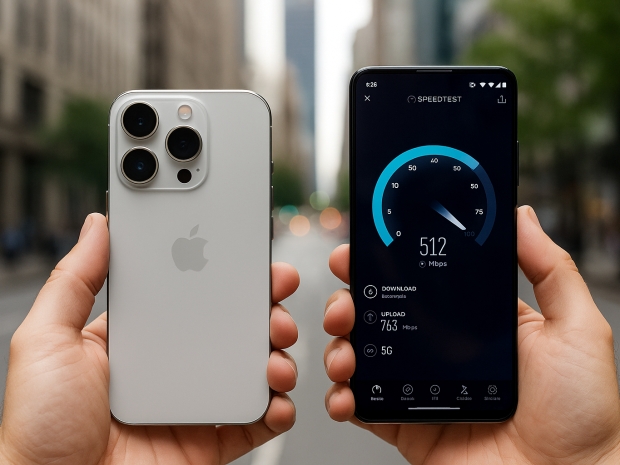According to a report from Cellular Insights, conveniently funded by Qualcomm, the iPhone 16e’s much-hyped C1 modem lagged behind Android phones using Qualcomm kit, particularly on T-Mobile’s 5G network in the urban jungle of New York.
The study found that while Apple’s chip held its own under perfect lab conditions, it struggled in the places where top-tier modems are supposed to shine: dense cities, indoors, or when uploading large chunks of data. In those situations, Qualcomm’s parts came out as quantifiably, repeatably and operationally superior.
Across a slew of locations and signal environments, Android devices came in between 34.3 and 35.2 per cent faster on downloads and up to a whopping 91 per cent quicker on uploads. The deeper indoors you go, the worse it gets for the iPhone 16e.
The report doesn’t mince words. It says Android’s 5G benefits aren’t just theoretical. They’re operationally significant, especially for city dwellers, indoor users, or anyone hammering the uplink.
The report said part of the problem is the C1 modem’s poor spectral efficiency. While Qualcomm’s kit handled wide TDD channels like 100 + 50 MHz n41 with aplomb and cranked out higher MIMO ranks, Apple’s modem floundered with low FDD usage and failed to exploit the bandwidth properly.
The Android phones had better carrier aggregation too. Both tested devices supported four-carrier downlink and TDD+FDD uplink aggregation. The iPhone 16e, meanwhile, was stuck with limited downlink capability and no visible ULCA support, which crippled its upload speeds.
Even on platform maturity, Android romped ahead. The Snapdragon X80 modem inside one of the test devices handled five-carrier downlink aggregation and featured compatibility with 5G-Advanced specs. The other Android, despite being a generation older, still clobbered the iPhone in performance.
Thermals didn’t help either. The iPhone 16e got toasty under load, forcing the screen to dim and the performance to throttle even in ideal conditions. This occasionally narrowed the gap but mostly just made the phone uncomfortable to use. Not quite what punters expect from a $599 next-gen device.
Jobs' Mob has been steadily trying to ditch third-party parts and replace them with its own silicon. The C1 modem is the latest attempt, hoping to shave costs and add another notch on its in-house chip belt, which already includes Mac and iPhone processors.
While CEO Tim Cook gushed about the C1 being the most energy-efficient modem ever in an iPhone, that claim seems less compelling when Android phones were reportedly up to 35 per cent faster at downloading data and 91 per cent faster at uploading. The performance gap widened when networks were overloaded or signals weak.
To be fair, the report didn’t go into battery life or long-term consumer experiences. Still, it’s not a good look for Jobs' Mob, which is facing the reality that modem tech is far harder to master than just cobbling together another M-chip.
Qualcomm has already warned investors that Apple’s business is likely to vanish, but reckons it can make up the shortfall elsewhere. This little PR stunt doubles as a warning shot that modem design isn’t amateur hour and it isn’t going quietly.




